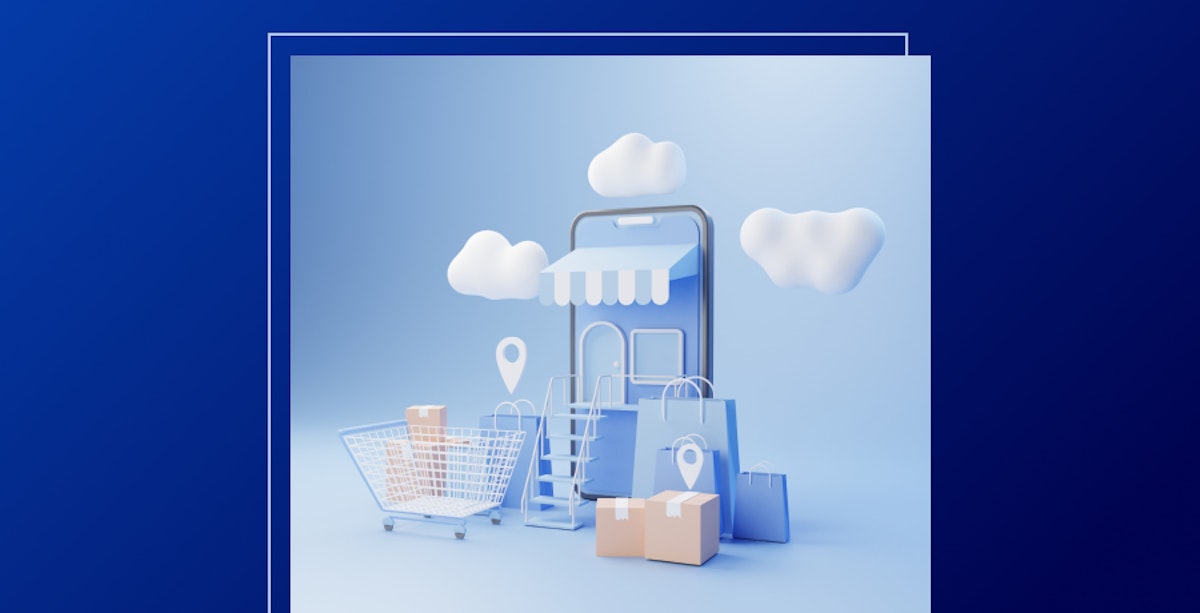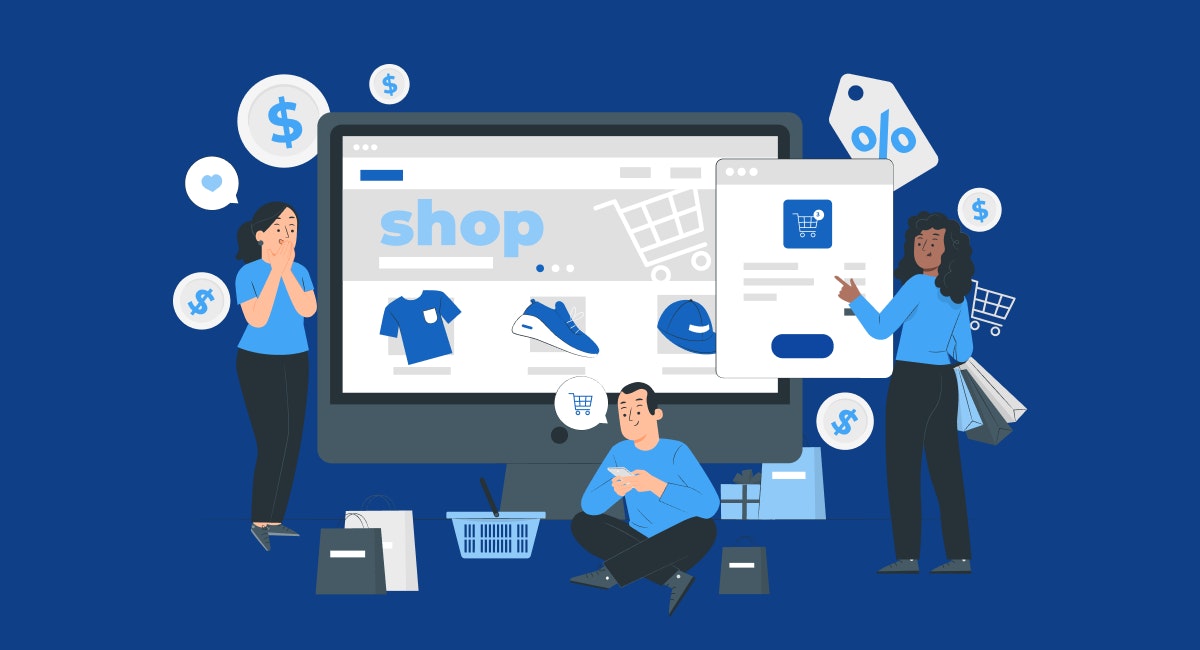Table of Content
The 2020 pandemic has caused significant disruptions to businesses across the globe. With most people confined to their homes due to lockdowns, many companies rapidly moved to a remote working model and an online selling medium. In a blink of an eye, consumers stopped going to supermarkets and grocers to stock up their homes.
Instead, they preferred the eCommerce shopping cart online with limited external contact. Quite interestingly, this arrangement worked in favor of retailers who were running low on funds and did not have the financial capacity to hire or maintain large workforces. The online model for selling and shopping for goods turned out to be favorable for all parties and how!
The remarkable growth of e-Commerce sales is astounding.
Ecommerce is disrupting the retail sector, and we have facts to support our argument. The global share of online retail sales in total retail sales is 16.4%. Ecommerce accounts for more than three-quarters of the overall retail growth.
In fact, 43% of online sales in the U.S. are driven by Amazon, while Flipkart has recorded a growth of 80% in India, a developing but crucial country in this day and age.
The surge can be attributed to the extremely smooth customer experience delivered by eCommerce companies. Features such as two-day shipping service, voice search, and product matching technology solutions help customers buy their favorite products faster.
The strong impact of eCommerce trends on retail
Ecommerce trends are changing the fate of the retail sector and its businesses by providing an excellent digital platform for shoppers. The impact can be seen on the entire retail landscape by offering an engaging shopping experience — both online and offline.
Brick and mortar retailers cannot keep up with the evolving industry trends. They are adopting new technologies such as building an online storefront or using augmented reality in their online stores to attract new and tech-savvy customers and retain the current base.
Some popular trends in eCommerce which are doing the rounds include:
- Integration of chatbots to enhance customer service and drive higher sales by tapping on impulse buys at the right time.
- Customized eCommerce solutions that enhance in-store customer engagement by leveraging communication via social media, website pop-ups, and newsletters.
- Deployment of voice search features on the website provides much convenience for the shoppers who do not want to work hard while shopping.
- Implementing AI in retail stores assists in making trial rooms and app searches discover the perfect style for customers hassle-free.
How eCommerce is affecting retail stores
Today's customers know what they want when they enter a store. They have researched online through the store's mobile app and checked all possible items they can purchase from the retailer.
Therefore, it is the eCommerce business' opportunity to provide an excellent experience, making it easy to acquire customers as quickly as possible. In this section, we will study how eCommerce is rejuvenating the retail sector by leaps and bounds:
1. Digitized brick and mortar operations
The use of mobile technology in physical stores is on the rise. The new breed of malls offers convenience and engaging interactions throughout the customer journey. In-store processes, including identification, engagement, and payment processing, are being digitized.
Studies indicate that 77% of shoppers prefer to shop at retail stores offering self-checkout technology. Therefore, it provides retailers the opportunity to serve customers in a way that heightens their experience with the store and compels them to make a sale at the earliest.
2. Enhanced customer engagement
According to a Marketo report, 75% of CMOs predict end-to-end customer engagement to drive the journey of their customers in the next three to five years. Online stores strive to build close and personal communications with customers.
Personalization of customer communication — pop-ups, messenger chats, push notifications, and emails- influences their buying decisions. Gathering feedback or reviews also helps enhance engagement and improve products.
3. Reduced sales journey
Chatbots are changing the way sales happen on websites in the retail sector. As customers wish to spend less time waiting to hear from sales and customer support teams, they prefer to communicate with chatbots.
They make customer interactions quick and straightforward for both buyers and sellers. The retail industry rapidly embraces AI using natural language processing (NLP) to make their communications more human-like via a retail eCommerce solution.
Sentiment analysis helps them understand customers better and meet their expectations. Retail stores can control costs and still stay competitive by implementing these technologies.
Leading retailers such as Sephora and Tommy Hilfiger have already found success with using chatbots on their sites, taking the shopping experience to another level.
4. Improved shipping options
Traditionally, transportation was a significant expense for retailers. However, as eCommerce retail becomes increasingly essential for businesses to thrive and shipping costs continue rising, rates of return on investment have decreased.
Leveraging analytical tools, retail businesses analyze customer data such as product search history, device usage, shipping locations, and other preferences to study customer behaviour. On top of that, the pricing of orders, parcel type, and time in transit helps you make critical shipping decisions on time.
On the other hand, drones are an exciting new way for retailers to deliver products more efficiently and quickly. The delivery drones will turn into a viable shipping alternative in most retail businesses very soon.
Amazon has already deployed and tested this technology in select regions. Drones undoubtedly promise to provide customers with a seamless shopping (and shipping) experience that further boosts the eCommerce business' brand loyalty regardless of their geography.
5. Increased conversion rates
Adoption of the latest technological tools such as Voice search is fast transforming the eCommerce industry. Implementing quick voice-based search features in the search bar of online retail stores driven by AI improves the customer experience.
By rapidly adopting the technology, eCommerce businesses strive to engage their target audience better, even those who rely on special techniques to access the site. Reports predict that digital voice assistants such as smart home devices will triple to 8 billion by 2023.
Personalized offers and convenience-driven solutions integrated on eCommerce platforms help build customer loyalty, and the emphasis on this will only increase in the years to come.
E-commerce Development Services | Intuz
Explore NowHow retailers plan to meet new customer expectations
Even the savviest retailers who spent years perfecting their omnichannel strategies to blend online and offline channels for engaging customers went through a period of transformation as the COVID-19 pandemic upended the world in early 2020.
The customer behaviours changed dramatically. As mentioned previously, in-person interaction was minimized, and it was more or less supplemented by increased digital engagement.
More specifically, eCommerce sales in apparel, beauty products, and department stores have increased on average. Looking forward, it is clear that retailers will have to build more resilience in the shopping experience they offer to their target audience. Here is how they can do that:
1. Double down on the digital platform
The pandemic has changed the way people shop, and retail companies are responding by changing their digital marketing strategies. The drop in revenue due to reduced footfall at physical locations can be balanced by increasing investment in online assets.
Ecommerce retailers need to pay attention to the shifting consumer behaviour by adapting their strategies. They must take into account keyword performance for paid searches.
Studying customer intent to improve "shoppability" of social media channels such as Instagram and Facebook. Distributing clickable content and notifying about featured products through social media posts can drive users directly to the retailer's digital store.
Retailers have also extended their digital presence by prioritizing a mobile app and accelerated their efforts to deliver a frictionless point-of-sale experience. They are also nurturing customer communities to increase customer interaction with the brand.
In order to stay competitive in the digital age, retailers must optimize their websites for online shopping. In addition to ensuring site speed, they must offer stability across devices as customers prefer shopping on their smartphones and tablets.
A clean interface with minimal interference on the online store helps you keep pace with rising customer expectations.
2. Inject innovation into omnichannel
Retailers need to be aware of changing customer preferences and behaviors to adapt their omni channel offerings accordingly. They must be able to align their efforts with emerging customer needs with fairness and ease.
The new methods, for instance, must be integrated into their existing channels for a consistent overall experience. In-store shopping has changed with the times, and some retailers are adapting by offering more of their in-person interactions online.
Leading brands such as Nike are already using virtual appointments to offer personalized attention from sales agents. They are also leveraging live streaming on social media platforms such as Facebook Live or Instagram Stories.
Experiential content and virtual try-on are facilitating engagement to increase revenue. A new type of ecosystem has been emerging in which retailers team up with other companies to provide services that add convenience to customers' shopping experience.
These strategic partnerships allow them access to new customers. The adoption of digital methods in retail also requires retailers to diversify their delivery mechanisms. The modes can be classified based on the speed of delivery to ensure each package reaches the customer on time.
3. Transform store operations and win
The pandemic has been a significant disruption for retailers. Customers are now more interested in getting home after buying their products quickly, rather than spending too much time in-store.
It means that store operations need to be reimagined with new safety features such as physical distancing or self-service stations.
Retail stores can drive in-store sales by implementing policies such as ensuring sanitary surfaces, cleaning between customer visits, and communicating proactively about updates. Offering a safer experience at their physical stores will help them regain customer trust.
To improve customer experience, retailers need to ensure a high level of safety and cleanliness. At the same time, these non-negotiable elements are essential for both customers as well as employees.
The workforce also needs redirecting from less relevant activities into priority areas such as those that pertain directly to the quality of service or store operation management. Proper training will increase productivity and impact revenue positively.
4. Reimagine the physical network
The pandemic has changed the in-store shopping experience. Ecommerce transactions have recorded a rise of 19% as brick and mortar stores were shut down. Retail businesses have lost more customers to online shopping than they expected.
Considering the critical role of physical stores, retailers should thoughtfully consider which stores to reopen as the situation subsides.
As retailers look at taking forward digital experiences within the physical stores to consider data-driven insights, they need to be aware of COVID-19's latest impact.
They should evaluate the physical network and optimize locations for sustainable business through the pandemic. Retailers are also experimenting with newer models of physical stores.
They are classifying stores into temporary and permanent to enable both faster delivery and a great physical experience. Stores with high footfall are encouraged with advanced tech tools such as smart vending machines, QR codes, RFID packages, digital price tags, and VR showrooms.
For example, Burberry is one of the most innovative high-end luxury retailers in integrating its online and offline networks. They have several different features that allow shoppers to virtually try clothes on or even go live from their smartphones during events at other stores across the globe. They genuinely sell a luxe shopping experience at their stores.
The future of shopping is eCommerce.
The future of retail is digital and will be driven by the internet. Retailers are providing more information about their products to customers and helping them make informed decisions.
Retail store operators and developers are working to create a variety of new experiences for shoppers. With the rise of eCommerce, retail stores are leading the change in innovations with integrated platforms.
They allow customers to access data from any device they use at their preferred time. This creates a favorable environment for the customers to make a decision in their sweet time — whenever and however they want to.
When eCommerce businesses do not pressure their customers to purchase from them, it results in a better shopping experience and thus higher sales.
Brick and mortar retailers will thrive in an environment where both physical and digital storefronts converge. From offering two-hour shipping to VR-based trial rooms, retailers are trying to put everything at the customer's fingertips.
Is WordPress a Good Platform For Your Ecommerce Business?
Explore NowIs your eCommerce store ready for the future?
Retailers are working to create new platforms that will connect the physical world of storefronts with online ones. The integration between these two concepts has been heavily influenced by customer behaviour.
Competing successfully in the eCommerce ecosystem requires retailers to provide a compelling customer experience. The next normal still has not entirely taken shape, and customer expectations will continue to shift in response to that.
That is why retailers should focus on customer experience and respond with innovation and agility in their omnichannel experiences. If you are looking for eCommerce solution services for your business and want a partner you can count on, worry not.
Intuz has worked on a variety of eCommerce projects and can help you sort out your requirements. So, what are you waiting for? Bank on that e-Commerce boom and simply drop us a line on getstarted@intuz.com or fill the contact form for us to get back to you at the earliest. Talk soon!





